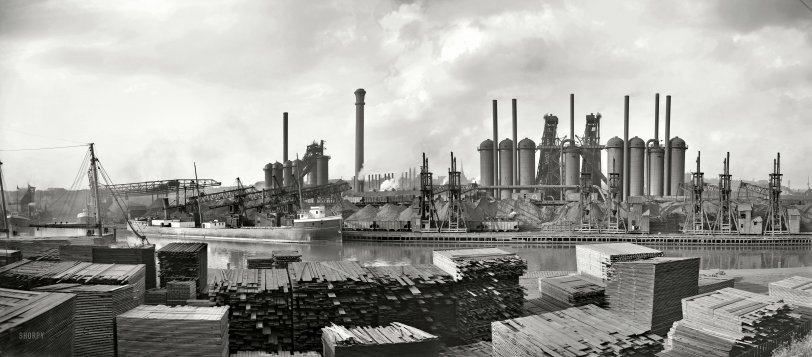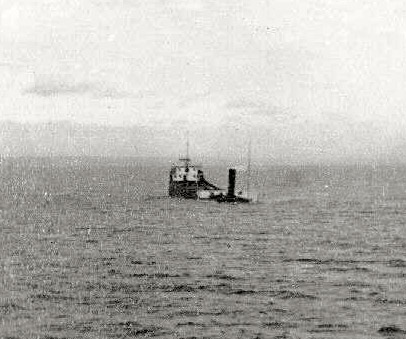


Framed or unframed, desk size to sofa size, printed by us in Arizona and Alabama since 2007. Explore now.
Shorpy is funded by you. Patreon contributors get an ad-free experience.
Learn more.

- Lofty addition
- In 1912
- Keenan Building
- Six years old
- Taken from the P.J. McArdle Roadway?
- It stood only 47 years
- Three track mind
- Incline to the right
- Reach for the sky, 1912 style
- No clean sweep
- Same Job Title, Same Face
- Sadly Lost
- Beautiful ...
- Where you get your kicks
- Aim High
- Pueblo Revival sisters
- Pueblo Neoclassicism
- Milk Man
- Regional dialect.
- Spielberg's inspiration
- Great Photo
- Loaf Story
- Do you still have the Rakes category?
- Could almost be a scene from the 1957 movie 'Hell Drivers'
- The Wages of Fear.
- Conspicuous by their absence
- Got Milk?
- All that aluminum
- No lefties
- Smoke 'em if you've got 'em
Print Emporium
American Steel: 1910

Cleveland, Ohio, circa 1910. "American Steel & Wire Co. plant." Your assignment: Create a diorama of this scene using toothpicks, cotton batting, string and cardboard. Panorama made from two 8x10 glass negatives. View full size.
H C Frick Coke Co. Boxcars
This was the company that belonged to Henry Clay Frick, who as chairman of the Carnegie Steel company was a integral part of the famous 1892 Homestead Steel Strike. As a result of his actions, he was dubbed "The Most Hated Man in America"
1882-1915
The carrier shown above on the Cuyahoga River is the S.S. Onoko, which found fame as both the world's first iron-hull bulk freighter and as the Great Lakes' largest vessel. Launched on February 16, 1882, at the yards of the Globe Iron Works in Cleveland for a group of investors led by Phillip Minch, great-grandfather of the late George Steinbrenner. At over 300 feet in length, the Onoko established a number of cargo-carrying records in the ore, wheat, and corn trades, and became the paradigm upon which virtually all subsequent Great Lakes freighters would be based. Her end came on September 14, 1915, when, just seven miles out of Duluth with a wheat cargo bound for Toledo, the Onoko sprang a leak on Lake Superior, the flood of icy water causing her boiler to explode. The ship's pumps unable to keep pace, she was abandoned by her crew, who were taken aboard the Standard Oil tanker Renown. A view of the Onoko's final minutes:

Stmr. Onoko
Washington Post, Jun 6, 1905.Great Lake Cargoes.
Immense Growth of Steamers on the Lakes Amounts to a Revolution.
From the Cleveland Leader.
The first cargo of the new steamship E.H. Gary, the record freighter of the Lakes, exceeds the greatest load ever before carried on these inland seas by almost as many tons as any Lake vessel had ever floated twenty-five years ago. It was in 1881 that the Onoko, a steamer built and owned in Cleveland, brought down the first load which reached the 3,000-ton limit. Now the record is placed at over 13,440 tons.In the twenty-four years the increase in the largest Lake cargo has been nearly 400 per cent. Taking due account of the time required to handle freight at docks and the average speed of heavy vessels between terminals, it is safe to say that one steamer like the E.H. Gary is equal to six such as the Onoko, the latter was a famous and very profitable boat for many years. The rate of progress indicated by such facts is little less than revolution in the business of the Lakes. It is a development rare even in this age and country.
American capacity for handling immense traffic is nowhere more strikingly illustrated than it has been in the traffic which has been built up largely by Cleveland men and Cleveland money, on the most remarkable chain of inland waterways in the world.
Coal Age, 1913.Coal Shipping on the Great Lakes
by J.W. Chamberlain
The first big revolution of bulk-freight carrying on the lakes came with the steamer "Onoko" in 1882, built of iron. Though not the first metal craft on the lakes, it had such an enormous capacity as compared with most wooden vessels that there was a rush for this new type. Older metal crafts had solved few problems, the first of them being the "Merchant," built in Buffalo in 1862. The "Onoko" merely showed the new possibilities in the size; she had two decks and the old-style stanchions to interfere with bulk-freight handling. ... Steamers of this class were derisively called "tin pans" and it was predicted that they would collapse in stress of weather. They did not, however, and soon a further step was taken, all in the interest of less obstructed holds to facilitate unloading bulk freight.
The ABC of Iron and Steel, 1915.Transportation of Ore on the Great Lakes
By Ralph D. Williams
In 1882, a departure from the use of wood as ship-building material was made by the construction of the steamer Onoko, at the Globe Iron Works, Cleveland, of iron. The Onoko was 287 feet long and 38 feet beam, and was for the time being the largest deadweight carrier on the lakes. In 1886 the first steel bulk freighter was built on the lakes — the Spokane, for the Wilson Transit Co., at the yard of the Globe Iron Works, Cleveland. Steel speedily became thereafter the only material used in the construction of bulk freighters.
My Project
Upon presentation of my assignment, is kerosene an acceptable liquid to represent the Cuyahoga?
[Yes! We will also allow the use of Popsicle sticks or tongue depressors. - Dave]
























On Shorpy:
Today’s Top 5